Address any questions or comments regarding this newsletter to the individual authors listed after each article or to its editors, Nathan Johanning, 618-939-3434, njohann@illinois.edu or Bronwyn Aly 618-695-6060, baly@illinois.edu. The Illinois Fruit and Vegetable News is available on the web at: http://ipm.illinois.edu/ifvn/. To receive or be removed from email notification of new postings of this newsletter, contact Nathan Johanning or Bronwyn Aly at the phone numbers or email addresses above.
In This Issue:
Upcoming Programs (listings for beginning and established growers)
Regional Reports (west central (x2), east central, St. Louis metro east, southern Illinois, Dixon Springs)
Fruit and Vegetable Production and Pest Management (Japanese Beetle, Corn Earworm, "Leps" in Cabbage Family Crops, Codling Moth and Oriental Fruit Moth, European Red Mites, Swede Midge a Threat to Illinois Crucifers, Manage Flea Beetles and Asparagus Beetles)
Upcoming Programs
Check the Illinois SARE calendar for a full list of programs and links for registration.
http://illinoissare.org/ and http://illinoissare.org/calendar.php
Also see the University of Illinois Extension Local Food Systems and Small Farms Team's website at:
http://web.extension.illinois.edu/smallfarm/ and the calendar of events at http://web.extension.illinois.edu/units/calendar.cfm?UnitID=629.
- Missouri Tomato Conference, Thursday & Friday, June 28-29, 2018. Cape Girardeau County Extension Center, 684 Jackson Trail, Jackson, Missouri 63755. University of Missouri Extension is hosting their second Missouri Tomato Conference. This conference includes presentations from Dr. Rick Snyder, Mississippi State University, Dr. Joe Kemble, Auburn University, several University of Missouri Extension Specialists, and growers. For more information contact Pat Byers 417-859-2044 or to register, visit www.facebook.com/MOStrikeForce/
- Southern Illinois Summer Twilight Series: Karl Sweitzer Produce, Monday, July 16, 2018 6 p.m. 50 Aldridge Rd, Cobden, IL 62920. This third twilight meeting of the summer series will cover vegetable production (summer & fall), succession planting, and marketing through farmers markets. For further information contact Bronwyn Aly at baly@illinois.edu or 618-695-6060. The other dates for the series are listed below:
- Cahokia Rice, McClure, IL August 20, 2018
- Produce Safety Alliance Grower Training Course, Monday August 13, 2018 8 a.m. – 5 p.m. Jefferson County Extension Office, 4618 Broadway, Mt. Vernon, IL. For more information on this grower training and to register visit http://go.illinois.edu/PSAMtVernon2018 or contact Laurie George at ljgeorge@illinois.edu or 618-242-0780. Registration will close on July 27, 2018. There are a limited number of seats available for this training. Once the course is full, registrations will close.
- 2018 Pumpkin Field Day, Thursday, September 6, 2018, 10 a.m. Ewing Demonstration Center (located about 20 minutes south of Mt. Vernon, IL) 16132 N. Ewing Rd. Ewing, IL 62836. Pumpkin Variety & Pest Management trials, No-till Production and more! Save the date; more details to come! For additional information contact Nathan Johanning at 618-687-1727 or njohann@illinois.edu.
- Midwest Mechanical Weed Control Field Day Wednesday September 26, 2018 PrariErth farm in Atlanta, Illinois. Visit https://thelandconnection.org/farmers/mechanical-weed-control-field-day-2018 for more details and information about the field day as time gets closer.
Regional Reports
From west central Illinois... This past week I've traveled from Central Illinois to nearly the tip of Southern Illinois, and of all the places I've visited, Quincy may be the driest place in the state. In Macomb, it has been quite hot, yet we have been lucky enough to get 1.5 inches so far this month. Most of the rain fell over the course of an hour. For many, this one rain event is more precipitation than we received during the entire month of May. Looking at the forecast, we are due for a stretch of thunderstorms predicted for every day this week. Fingers crossed!
Japanese beetles have emerged in Central Illinois. This past weekend on the road, we drove through "clouds" of Japanese beetles south of Carthage. Products containing the active ingredient carbaryl are the most commonly used in home gardens. It gives good residual control for at least one to two weeks. Home and market gardeners need to watch the post-harvest interval when applying pesticides. Those seeking organic alternatives can turn to products containing pyrethrins (PyGanic). Pyrethrins break down quickly when exposed to UV light, therefore apply in the evening to avoid exposure to sunlight as much as possible to stretch the residual of the product. The University of Missouri is studying mass Japanese beetle traps as another organic option. Researchers modified 32-gallon trashcans into massive Japanese beetle traps. They then use the traps to divert the bulk of the feeding beetles into the trashcans. We are experimenting with this type of trap in Macomb.
If you have an automated irrigation system, don't forget to check on it at least once a week. Today I used the irrigation controller to cycle through each valve. I walked the irrigation lines checking for leaks and feeling the soil around plants to make sure the system is delivering enough water, but not saturating plant roots. Each bed is watered in the morning. As the weather gets hot, I have programmed the system to kick on mid-afternoon for any crops that are not mulched, as I've noticed those have begun to dry considerably in our 90 plus degree weather. Base your irrigation cycle on soil type, drainage, crop, and weather. You can install a rain or moisture sensor on most mid- to high-end irrigation controllers. If the sensor detects excess moisture, it will override the controller programming and keep the valves closed, saving you water.
Chris Enroth (309-837-3939; cenroth@illinois.edu)
Also from west central Illinois... The dry weather is getting serious. If it doesn't rain this week, I don't know that those crops not provided supplemental irrigation will produce anything. Since April 1st, my rain gauge has only recorded 3" of rain, and during June, with all this heat, we've received less than .2". I can't remember the last time we had a dew here. It was sometime during strawberry season, probably the end of May. Usually this time of year, the morning dews are prevalent, but not so this year. Just no soil moisture to draw from. The brown color of lawns here reminds you of mid August.
When it does rain, the weeds will have a grand time, as we've had no rains that totaled more than .75" this year to help incorporate the herbicides. But at the present, there really aren't many weeds to speak of, and those that are present are very shallowly rooted, so very easy to eliminate.
Unless provided water, crops are not progressing. Field and sweet corn has been leaf rolling, some fields for over three weeks, for several hours each day. Rolling leaves is the plants response to lack of water and helps the plant survive by reducing leaf evaporation. The plant simply goes into self defense, it shuts down, which allows it to survive another day. But at the same time, it isn't photosynthesizing, which untimately means the plant isn't maturing. The first planted sweet corn began silking June 13, but due to the dry soils, the corn isn't maturing at an even pace across the field. You can certainly tell the good soils from the not so good soils by the way the crop responds during the heat of the day. I set up our Corn earworm (CEW) moth trap then and have been catching between 8-65 moths per night. The average catch is 33, and with the high temperatures, I've been treating for CEW on a two day schedule. We're using Beseige as I don't want to discover that we've got pyrethroid resistant populations after the fact.
The first high tunnel tomatoes are ripe, as are peppers. Zucchini, squash, potatoes and other "summer" crops are all being harvested. I had to spray one tunnel several weeks ago for spider mites, and discovered the other tunnel had them as well just this past week. I also included in the spray a pyrethroid and Quadris (for leaf mold). Leaf mold is a perennial issue we and other high tunnel growers have to contend with almost every year. I've not seen it yet, but included it as a preventative.
Any crop planted during the past two or three weeks required supplemental moisture in order to germinate. So we're laying trickle tape over each pumpkin row. It's slow going but at least we have a start on the crop. We're not done yet.
Mike Roegge, Retired Extension Educator & Mill Creek Farms (roeggem@illinois.edu)
From east central Illinois... In the past two weeks, the CSA's have begun delivering subscriptions and the farmers markets started getting more vendors with vegetables. This is about a week to 10 days later than usual due to the cool, wet spring delaying field plantings. Japanese beetles are have make their presence known on asparagus and fruit trees. Raspberries and blackberries are quickly ripening and growers are getting the message to pick fruit at almost ripe stage and refrigerating, instead of picking fully ripe to reduce the risk of SWD larval emergence in ripe fruits.
Rainfall as been spotty across the region with some farmers getting deluges and others getting nothing. Crops are growing rapidly in the warm temperatures as long as there is adequate rainfall or irrigation. The down side is that weed pressure has increased especially in areas with above normal rainfall combined with the warm temperatures.
Doug Gucker (217-877-6042; dgucker@illinois.edu)
From the St. Louis Metro-east... The region has been under an excessive heat advisory. Up to 105°F due to temperatures in the mid to upper 90s and dewpoints in the lower 70s. Stifling, there is no other word for it. Though the U.S. Drought Monitor doesn't show it, the area could use some rain..."the money making kind of rain" as one grower succinctly put it. The current forecast has a fairly high probability of rain Wednesday through Friday which includes a brief respite from high temperatures before gradually climbing again.
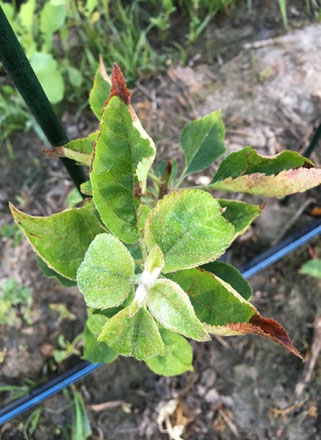
Potato leaf hopper damage in apples.
Photo with permission from anonymous.
Early blackberries like Natchez and Prime-Ark Freedom are in harvest. Black raspberries are red and ripening towards black. Though early cultivars of peaches and blueberries are in harvest in more southern parts of the state, the metro-east is very close...probably by the end of the week. Lodi apple will probably be ready by the first week of July. The grape crop is progressing, and many grower are still thinning and combing shoots. Just as an added note. In my "less common" fruit test planting at home, I have a crop of elderberries, apricots, red currants, Saskatoon, cornelian cherry dogwood and medlar. The gooseberries and loganberries faired to fruit this year. The apricot crop was a real surprise since my peaches and sweet cherries failed to crop.
The region is very close to early sweet corn harvest, meaning there will be local sweet corn for the 4th of July target date. Tomatoes are in harvest, mostly tunnel and small-fruited field tomatoes. Taste is excellent with all this dry weather. Main season tomatoes from Arkansas are currently on the market, so it won't be long before local tomatoes replace them. As reported in the last newsletter, most vegetable crops are in harvest.
I have been sent images from a few growers asking me to identify what they suspect was herbicide drift on apple. In all cases so far, the culprit was potato leaf hopper. Potato leaf hopper feeding on apple can cause curling of the leaf edges and chlorosis/necrosis along a fully expanded leaf edge. Young leaves can be entirely affected. If you see leaves that appear to be chemical burned in this manner, scout on the underside of the leaf for potato leafhopper and consult the Midwest Fruit Pest Management Guide for your best control option.
Elizabeth Wahle (618-344-4230; wahle@illinois.edu)
From southern Illinois...We are actually entering the first official days of summer with a few of the cooler days we have had lately with highs in the 80s. Otherwise it has been very hot and humid with highs in the mid 90s and lots of sun. The heat has fueled pop up storms which have been more wide spread lately but rain totals have varied from a couple tenths to a couple inches depending on where you were. Most areas are fairly dry to the rain is welcomed.
Out in the field, summer squash, cucumbers, green beans are in harvest and the first sweet corn won't be far off either. Early blackberries, black raspberries, and early and mid season blueberries are coming in. Out in the orchard, we are just getting into the first of the early peach varieties.
Nathan Johanning (618-939-3434; njohann@illinois.edu)
From Dixon Springs Ag Center...We are continuing with cucumber harvest every other day, along with pruning and lowering of vines. Many of the plants have vines that are at least 12-15 feet in length, with the current harvest zone within the last 5 feet of growth (see picture below with Julie as a height reference, she's 6'). Harvest and replanting of various greens continues in both the hydroponic and in-ground systems. Several of the tomato varieties are starting to ripen, with the first harvest earlier this week. Peppers in ground beds are starting to size, with some getting close to harvest by the end of this week or early next week. The cut flower plots are on their third harvest, along with weekly trimming of the basil, cilantro, and parsley. Onions are starting to size, along with the celeriac and fennel. Kohlrabi is also ready to harvest, with sizes ranging from baseball to softball. No new insect pests have been observed, just a few sightings of flea beetles, aphids, and lady bugs. We have been happy to host three different groups in the past week, demonstrating to a wide range of individuals the differences in high tunnel structures, production practices, and management strategies.
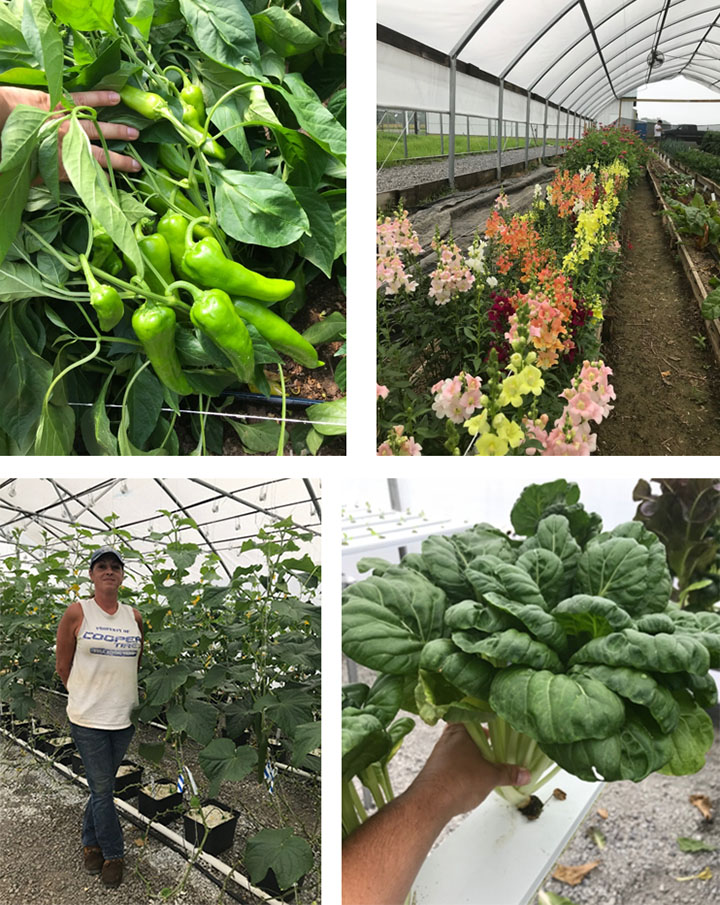
Clockwise from top left: Sweet banana peppers, snap dragons, hydroponic cucumbers, and tatsoi grown in the lettuce table. Photos by B. Aly.
Bronwyn Aly (618-382-2662; baly@illinois.edu)
Fruit and Vegetable Production and Pest Management
Japanese Beetle
I saw my first Japanese beetle of the 2018 season on June 13 in far southern Illinois. By June 15, it was common to observe dozens on a single leaf or shoot in grapes and peaches.
Japanese beetle larvae - grubs - feed on the roots of a wide range of grasses and can be serious pests of turf. Adult Japanese beetles feed on the fruits and foliage of over 275 different plant species. Among the host plants that they prefer the most are roses, grapes, American linden, cherry, plum, peach, apple, flowering crab apples, Norway maple, and Japanese maple. They also feed on foliage of several vegetable crops and on silks of sweet corn.
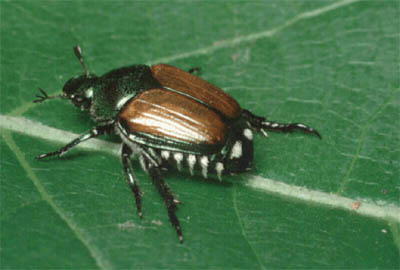
Adult Japanese beetle.
Mature larvae of the Japanese beetle pupate in the soil in late spring, and adults emerge from June through August. Females emit a sex pheromone to attract males, and mating occurs in the grasses where the adults emerge; additional matings occur later on the plants on which adults feed. Because emergence from pupae spans a period of several weeks and adult beetles can live for several weeks as well, Japanese beetle adults may be present from June through October in at least some areas. Larvae hatch from eggs in July, August, and September, and they feed on the roots of grasses until cold temperatures trigger their movement downward in the soil profile. In the spring, partially grown larvae move upwards in the soil and resume feeding on roots. They pupate in May and June.
Management: Biological control agents and soil insecticides are available for reducing numbers of Japanese beetle larvae in soil. However, if the goal is to reduce adult damage to fruit or vegetable crops or ornamental plants, the great mobility of adult beetles limits or negates the value of larval control unless it is practiced on an area-wide basis. Most fruit and vegetable growers must focus on adult control to limit crop losses. Although traps that attract and kill great numbers of Japanese beetles are marketed widely, studies have shown repeatedly that these traps do not reduce beetle populations enough to protect nearby plants, and in some instances damage is greater on plants near traps than on those in areas where traps are not used at all. Exclusion (by use of plant covers) and the use of insecticides are the only effective options for protecting crops from Japanese beetle adults. Plant covers (with textures similar to floating row covers) can be practical for protecting small numbers of blueberry plants or a very few small peach or apple trees when fruit is ripening, but covers rarely are feasible for most crops and situations.
Insecticides labeled for use on fruits and vegetables for Japanese beetle control are listed in the Midwest Fruit Pest Management Guide 2018 and in the 2018 Midwest Vegetable Production Guide. In general, Sevin (carbaryl) or any of the common pyrethroids (Asana, Baythroid, Danitol, Mustang Maxx, permethrin, and Warrior ... and generic versions of these) are effective for killing beetles present in the crop when it is sprayed. Assail used in apples and peaches as a cover spray for codling moth or oriental fruit moth control will kill Japanese beetles as well. For organic growers, the insecticide Azera (contains a plant-derived pyrethrin plus neem) is the most effective of OMRI-listed products for adult Japanese beetle control. Three things to keep in mind: (1) Check the 2018 Midwest Fruit Pest Management Guide and the 2018 Midwest Vegetable Production Guide to make sure which insecticides are labeled for which crops. (2) Also check these references for listings of preharvest intervals (PHIs, the number of days that must elapse between last application and harvest) for each product in each crop. (3) Have realistic expectations for whatever you use for Japanese beetle control. An effective insecticide will kill adult Japanese beetles in the field or orchard block when it is treated and provide some residual control for at most a few days. Within 4 to 5 days after sprays are applied, scout fields or orchards for re-infestation by beetles that fly in from surrounding areas, and re-treat as needed.
Corn Earworm
Some brief reminders ... Last year's March 8 issue of this newsletter included a lengthy summary of corn earworm biology and control (Volume 23, Issue 3, 2017). You can read the entire article there, and the summary I included then remains pretty much unchanged for 2018 ...
- Buy a trap and lures (details at Volume 23, Issue 3, 2017) Check the trap daily when corn begins to silk. Replace lures every 14 days.
- When to spray ...
- Moderate pressure: If field corn in the area IS SILKING and traps are catching more than 5-30 earworm moths per night, spray every 3 days, beginning 2 days after first silk and ending 4-5 days before harvest.
- Moderate pressure: If field corn in the area IS AT BROWN SILK OR LATER and traps are catching 1-30 earworm moths per night, spray every 3 days, beginning 2 days after first silk and ending 4-5 days before harvest.
- High Pressure: If traps are catching more than 30 moths per night, spray every 2-3 days and always use a combination of a pyrethroid and an alternative chemistry.
- What to spray ...
Choose a Pyrethroid + Choose an Alternative |
Or use a pre-mix |
|
|
|
|
- Bt (GMO) sweet corn ... You might be using Bt sweet corn, especially for your late plantings. Because of recent reports of corn earworm resistance to one or more Bt toxins produced in Bt corn, expect the Attribute II Bt sweet corn varieties from Syngenta to provide the best earworm control. These contain what's sometimes called the Viptera trait. If you are growing any Attribute II varieties in order to diminish likely infestations, I suggest you treat them about the same as you would treat a non-Bt variety ... but you should expect to get a full harvest without significant infestations.
"Leps" in Cabbage Family Crops
I'm beginning to see diamondback moth in some cabbage family plants where pyrethroids have been applied a few times this season. Be sure to scout crops such as cabbage, broccoli, Brusssels sprouts, and leafy greens such as kale. The "Leps" (caterpillars, larvae in the order Lepidoptera) that feed on these crops are diamondback moth, imported cabbage worm, and cabbage looper. Although pyrethroids including Asana, Baythroid, Danitol, Mustang Maxx, permethrin, and Warrior (and generic versions of these) are labeled for and generally effective against all three of these species, pyrethroid-resistant populations of diamondback moth are widespread. Repeated use of pyrethroids throughout the season results in buildup of diamondback moth larvae resistant to them. Where diamondback moth larvae are the target of insecticide applications, especially early in crop development but really at any time of season, use Bacillus thuringiensis (BT) products (such as Agree, Biobit, Dipel, Javelin, and Xentari), Coragen, Entrust, Exirel, or Radiant. BT insecticides and Entrust are OMRI-listed for use in organic production.
Codling Moth and Oriental Fruit Moth
These are the most prevalent "worm in the apple" (codling moth) and "worm in the peach" (oriental fruit moth) wherever these crops are grown in North America. Both of these species undergo multiple generations of development each season in Illinois.
Although pyrethroid insecticides are effective for codling moth control in apples, they also kill predaceous mites and lead to outbreaks of European red mites, so pyrethroids generally are not used for codling moth control in apples. Most codling moth populations in Illinois appear to be resistant to Imidan, and it is no longer dependably effective for codling moth control. Effective insecticides for codling moth control in apples include Altacor, Assail, Delegate, Exirel, and Rimon. To lessen the risk of resistance development, do not use more than 3 consecutive applications of any one of these insecticides.
Pyrethroids have been used widely for oriental fruit moth (OFM) control in peaches, but pyrethroid resistance in OFM populations has rendered them ineffective in at least two southwestern Illinois counties. At this point in the season, it is too late to use mating disruption for OFM control, so cover sprays of Altacor, Assail, Delegate, Exirel, or Rimon most effective.
For both species, these cover sprays remain effective for 14 days or longer after application if they are not washed off by rains. There is no better way than using pheromone traps to determine when sprays are needed to control codling moth and oriental fruit moth (see the March 24, 2018 issue of this newsletter Vol.24, no. 3). Check traps at least twice weekly and record counts by date. When male moths are being captured in traps, egg-laying by females is going on at the same time. Eggs hatch a few to several days after they are laid on fruits or shoots, and they tunnel into fruits then. The insecticides listed above do not kill a high percentage of adult moths, but their residues from cover sprays on fruit kill eggs or newly hatched larvae ... so the goal is to have a residue on fruit when larvae hatch from eggs. For codling moth, eggs hatch about 240 degree days (base 50 F) after they are laid. To decide whether or not a fresh cover spray is needed after the previous one dissipated or was washed off, look back to see if your traps were catching moths 240 degree days ago. To adequately estimate the number of degree days that accumulated each day, calculate the daily average temperature ([low temp + high temp] divided by 2) and subtract 50. This is not precise in all temperature ranges, but it's adequate for this purpose. Where there is a significant gap in moth flight between generations, you don't need to have a cover spray on for codling moth control when no eggs are hatching. The most important timing for each of the 4 or more generations of OFM that develop each year is 170 AND 350 degree days base 45 F after the first moths of each generation are caught in pheromone traps.
European Red Mite
I have seen European red mite infestations near or above threshold densities (5 mites per leaf) in multiple orchards in southern Illinois over the last 10-14 days. The table below lists miticides that are effective against European red mites in apples and peaches and the pre-harvest intervals for each. Agri-Mek, Apollo, Onager, and Savey are considered to be good miticides early in the season but are not as effective for mid-summer mite control. For resistance management, do not use mitcides in the same mode of action group more than twice in succession (even over two seasons).
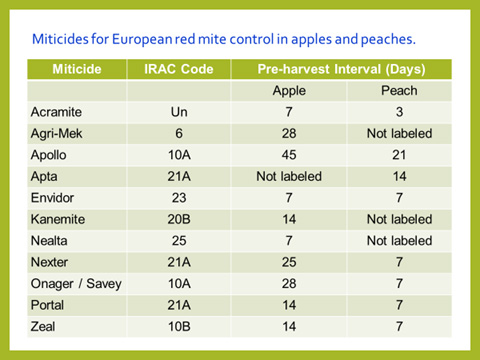
Rick Weinzierl, Weinzierl Fruit and Consulting, LLC (217-621-4957; raweinzierl@gmail.com)
Swede Midge a Threat to Illinois Crucifers
The swede midge was confirmed for the first time in Illinois last July in a homeowner garden in Cook County. This insect is a serious pest of cruciferous plants such as cabbage, cauliflower, and broccoli.
We know very little about its potential distribution in Illinois at this point. Swede midge is widespread in the northeastern U.S., an invasive pest, it is native to Europe and Southeast Asia.
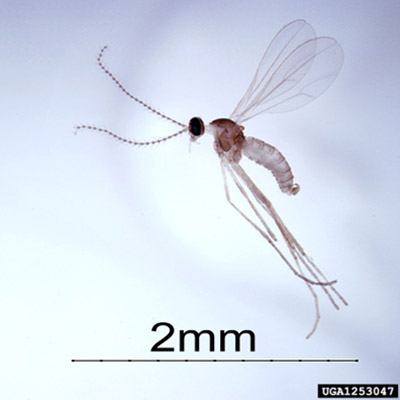
Figure 1. Swede midge adult fly. Photo by Susan Ellis, USDA APHIS PPQ, Bugwood.org.
While the greatest damage caused by the swede midge has been on broccoli, there are many potential cruciferous host plants in the Brassicaceae family such as broccoli, Chinese broccoli, Brussels sprouts, cauliflower, Chinese cabbage, and other Asian greens. Non-cultivated plants in this family may also be infested (wild mustard, shepherd's purse, wild radish, field pennycress, and yellow rocket).
It is important to look for larvae on or within the plant tissue feeding near the growing points. Larvae are generally found feeding in groups. They are transparent but become increasingly yellow as they age. Full size larvae are 2-4 mm in length. The larval stage is the only life stage that can damage the plant. As they feed, larvae produce a secretion that breaks down the plant cell wall allowing the larvae to feed on the liquid contents. This changes the physiology of the plant and results in the formation of swollen, distorted and twisted tissue. Feeding caused by the swede midge includes leaf puckering, scarring, galls, or other deformities. There are lots of different causes to symptoms such as these, making it difficult to distinguish not only from other related insect species (midges, gnats, and mosquitoes), but also other factors such as mechanical injury from cultivation, herbicide injury, genetic variation of the plant, and heat or cold stress.
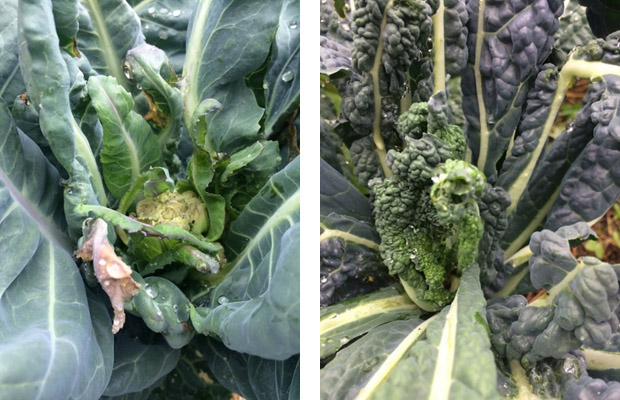
Photos: Left - Swede midge damage on cauliflower, causing small head and leaf puckering. (University of Minnesota).
Right -Swede midge damage on kale – note twisted and puckering leaves. (University of Minnesota).
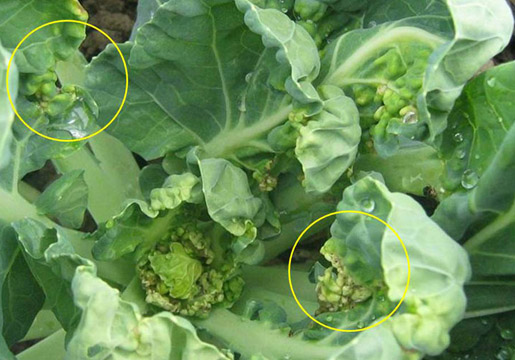
Photo: Swede midge damage on broccoli – note puckering (Cornell University).
Breakdown of swede midge damage on crops (http://web.entomology.cornell.edu/shelton/swede-midge/damagecrops.html):
- Puckered and crinkled leaves
- Leaf puckering can give a drawstring effect
- Swollen tissue of leaf petioles/bases
- Brown scarring at growing point
- Distorted growing points including twisting
- Presence of secondary bacterial rots
Swede midge damage increases:
- as the number of larvae feeding per plant increases
- the earlier in development that the plant is infested (i.e. damage pre head formation is more damaging because it could result in blind heads)
- later in the season as the population builds
- in sheltered areas near hedgerows, buildings, treelines, etc. where populations tend to build
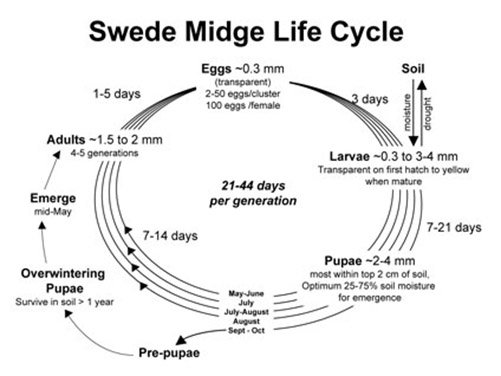
Research from Canada indicates that swede midge adults will emerge continually from the end of May to the end of September. Adults will lay eggs in new growth of host plants and larvae will feed on plant tissue until they are ready to pupate. Because of the multiple, overlapping generations each year, there is a potential for swede midge activity throughout the growing season.
As mentioned above, we are uncertain if and where other swede midge populations may be in Illinois. Confirmation of Swede midge in new locations will require specimens of adult flies. Samples of infested plants with larvae can be held until flies emerge for identification or traps can be placed to capture adult flies in the growing field. The adult fly is very small, about 1-2 millimeters in length, and requires an experienced entomologist to differentiate them from other related midges.
If you believe you have swede midge present in your fields or gardens, we encourage you to follow the steps from Cornell (http://web.entomology.cornell.edu/shelton/swede-midge/monitoring.html) detailed on their Scouting for Swede Midge page. If you have questions or think you are dealing with swede midge, please contact Kelly Estes (kcook8@illinois.edu).
Great Resources for Swede Midge can be found at the Swede Midge Information Center for the U.S.
(http://web.entomology.cornell.edu/shelton/swede-midge/index.html)
Kelly Estes, State Survey Coordinator, Illinois Cooperative Agricultural Pest Survey (217-333-1005; kcook8@illinois.edu)
Managing Flea Beetles and Asparagus Beetles
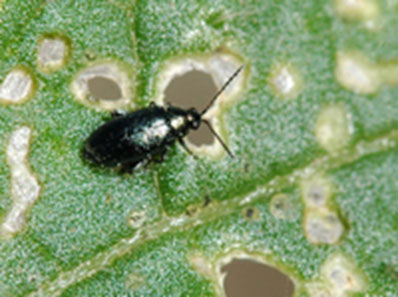
Flea Beetle. Photo by Jeff Hahn.
Flea beetles have the ability to jump and look similar in appearance to fleas. Adults are ~1/10th of an inch, and in large numbers they can quickly defoliate and kill many vegetable crops, especially cole and mustard plants. In this picture, foliage has been eaten and punctured by flea beetles.
Cultural Control
- Weed control removes food reserves needed by developing larvae
- Remove old crop debris to deprive protective cover for overwintering beetles
- Plant crops later when it is warmer to allow faster crop growth
Physical Control
- Use row covers during seedling stage
- Planting a trap crop, like radish, before main crop, then kill them off
Biological Control
- Beneficial nematodes applied to the soil destroy larval stages
- Braconid wasp parasitizes the larval form of the flea beetle
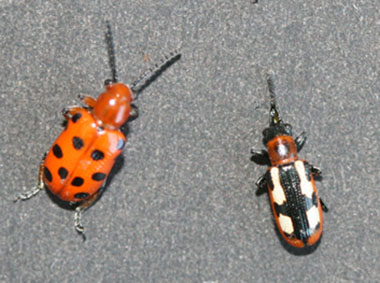
Photo by J. Theuri.
The common asparagus beetle, Crioceris asparagi, (right) and the spotted asparagus beetle, Crioceris duodecimpunctata, (left) are pests of asparagus. Distinguishing between the two species is important because the common asparagus beetle is more prevalent and causes more damage.
Scouting and managing the two pests is reviewed in Illinois Fruit & Vegetable News found in this link: https://ipm.illinois.edu/ifvn/contents.php?id=59
James Theuri (815-933-8337; jtheu50@illinois.edu)
Less Seriously...

https://www.pinterest.com/pin/783907878860404627
University of Illinois Extension Specialists in Fruit and Vegetable Production & Pest Management
Extension Educators – Local Food Systems and Small Farms |
||
Bronwyn Aly, Gallatin, Hamilton, Hardin, Pope, Saline, and White counties |
618-382-2662 |
|
Katie Bell, Franklin, Jackson, Perry, Randolph, & Williamson counties |
618-687-1727 |
|
Sarah Farley, Lake & McHenry counties |
847-223-8627 |
|
Nick Frillman, Woodford, Livingston, & McLean counties |
309-663-8306 |
|
Laurie George, Bond, Clinton, Jefferson, Marion, & Washington counties |
618-548-1446 |
|
Zachary Grant, Cook County | 708-679-6889 | |
Doug Gucker, DeWitt, Macon, and Piatt counties |
217-877-6042 |
|
Erin Harper, Champaign, Ford, Iroquois, and Vermillion counties |
217-333-7672 |
|
Grace Margherio, Jackie Joyner-Kersee Center, St. Clair County |
217-244-3547 |
|
Grant McCarty, Jo Daviess, Stephenson, and Winnebago counties |
815-235-4125 |
|
Katie Parker, Adams, Brown, Hancock, Pike and Schuyler counties |
217-223-8380 |
|
Kathryn Pereira, Cook County |
773-233-2900 |
|
James Theuri, Grundy, Kankakee, and Will counties |
815-933-8337 |
|
Extension Educators – Horticulture |
||
Chris Enroth, Henderson, Knox, McDonough, and Warren counties |
309-837-3939 |
|
Richard Hentschel, DuPage, Kane, and Kendall counties |
630-584-6166 |
|
Andrew Holsinger, Christian, Jersey, Macoupin, & Montgomery counties |
217-532-3941 |
|
Extension Educators - Commercial Agriculture |
||
Elizabeth Wahle, Fruit & Vegetable Production |
618-344-4230 |
|
Nathan Johanning, Madison, Monroe & St. Clair counties |
618-939-3434 |
|
Campus-based Extension Specialists |
||
Kacie Athey, Entomology |
217-244-9916 |
|
Mohammad Babadoost, Plant Pathology |
217-333-1523 |
|